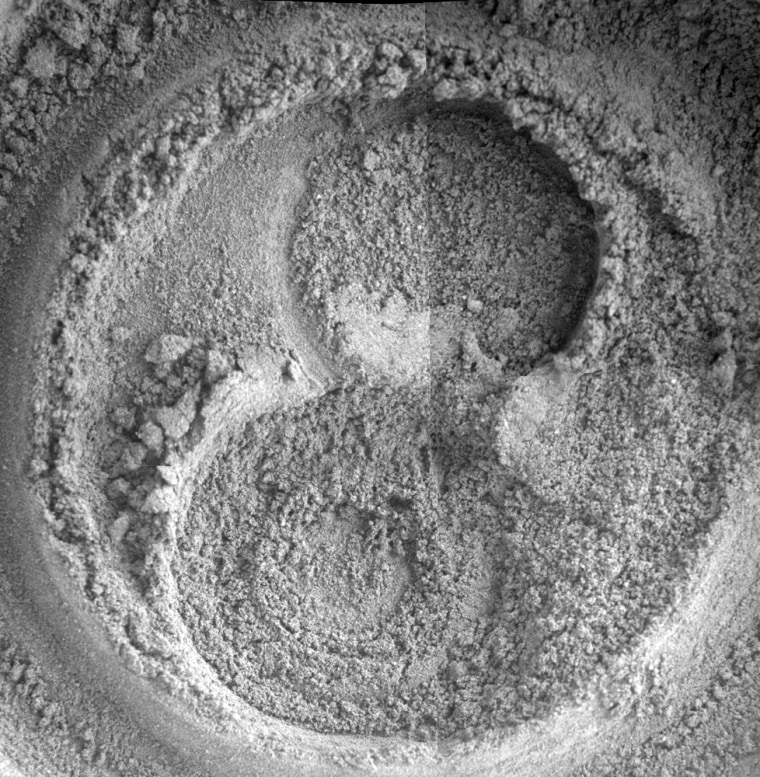Those “never say die” robots on Mars — NASA’s Spirit and Opportunity — continue to chalk up science at their respective exploration sites.
Looming large for the Opportunity rover at Meridiani Planum is Victoria Crater — a grand bit of territory that’s roughly half a mile (800 meters) in diameter. That’s about six times wider than Endurance Crater, a feature that the rover previously surveyed for several months in 2004, gathering data on rock layers there that were affected by water of long, long ago.
“We are closing in ... we’ve got only about a kilometer to go now,” said Cornell University's Steve Squyres, lead scientist for the twin Mars exploration rovers.
“Feel free to work out your own guess at an estimated time of arrival based on our recent progress … but I’m not making any predictions! Mars has fooled us too many times before,” Squyres told Space.com.
Lay of the land
Pushing across Meridiani Planum has not been easy for Opportunity. The landscape is one of rolling ripples of sand and splashes of outcrop rock.
“We’re pushing as hard as we can with a very old rover,” Squyres added. “We’ll get there when and if we get there.”
Once there, Squyres said that the plan is to approach that feature much as they did Endurance Crater.
“[We’ll] start by taking images from several points along the rim to get the lay of the land … and then see if there’s a place where we can enter the crater safely,” Squyres said. “There’s no guarantee that we’ll be able to get in, of course, but we’re not driving all this way just for the view.”
Rim shots
Also anxiously awaiting Opportunity’s hoped-for wheeling up to Victoria Crater is William Farrand, a research scientist at the Space Science Institute in Boulder, Colo. He is a member of the Mars Exploration Rover science team.
“The rover has been making good progress towards Victoria Crater. So — knock on wood — it should get there perhaps as early as late July,” Farrand told Space.com. “We will be getting just amazing images when we get to the rim of Victoria Crater.”
Farrand said the views at that feature are sure to be spectacular. But the real payoff, he added, is to check out the exposures of outcrop that the science team is expecting to see on the inner walls of Victoria Crater.
“Opportunity’s mission has been all about reading the story contained within the layered rocks that lie just below the surface of Meridiani Planum,” Farrand advised. “We got about 40 to 50 centimeters of outcrop at Eagle Crater [at the start of its roving], and then 7 meters at Endurance Crater.”
However, it looks as if there’s an even deeper story at Victoria.
Images taken from Mars orbit suggest something like 65 feet (20 meters) of outcrop might be exposed in the walls of Victoria Crater, Farrand stated.
It is still not clear whether rover scientists will be able to get into the crater to do the type of detailed, on-the-spot analysis that they were able to do within the inner rim of Endurance Crater.
But Farrand said that by using Opportunity’s panoramic camera and miniature thermal emission spectrometer, researchers should be able to do some tremendous remote sensing at that locale.
Spirit: Making it through winter
On the other side of Mars, within Gusev crater, sister robot Spirit is devotedly engaged in gathering science data, too. It’s in need of a little dental work, however.
The robot’s grinding teeth have worn away on its arm-mounted rock abrasion tool — but only after exposing interiors of five times more rock targets than its design goal of three rocks. The tool still has useful wire bristles for brushing targets.
“Spirit has been very busy lately, taking an enormous panorama that we call the McMurdo Pan,” Squyres reported. The robot is doing lots of work with its robot arm.
Spirit has been positioned in such a way that its solar panels can help the machine endure several months of Martian winter.
The power on Spirit is good, Squyres noted. Projections of the rover’s overall health, he said, suggest the robot will make it through the Martian winter and be able to keep doing science the whole time.
“One thing about staying in one place for a long time is that it enables lots of interesting science that just isn’t possible when you’re always moving. We’re taking advantage of that now with Spirit,” Squyres explained.
The ‘eyes’ have it
Both Spirit and Opportunity are churning out travelogue-style photos of their respective treks over Mars. The eyes of the robots — their camera systems — are capturing a wide range of scenery along the way.
“All of the cameras continue to work remarkably well and are continuing to acquire beautiful images,” said Cornell astronomer Jim Bell, the panoramic camera payload element lead for the Mars Exploration Rovers. “They have proven to be extremely robust to the extreme conditions on the Martian surface … large temperature swings, fine dust everywhere, large cosmic ray flux,” he told Space.com.

Since the twin rovers independently landed on Mars in January 2004, Spirit’s cameras have taken about 82,000 pictures. Opportunity has taken about 71,500 pictures, for a combined downlinked image data volume of about 19 gigabytes. About 54,400 of Spirit's images and 49,500 of Opportunity's are high-resolution panoramic images, Bell said.
“At Meridiani, once we get to Victoria Crater in June or July we are obviously looking forward to remarkable views of the interior,” Bell said. The pictures should help identify possible routes to explore even deeper exposures of sedimentary outcrop rocks.
“At Gusev, we are hunkered down for the winter now, obtaining detailed chemical measurements on reachable rocks and soils and acquiring the gigantic 360-degree McMurdo panorama with little or no compression in all [camera] filters from our winter haven parking spot,” Bell said.
Up there on Mars, Bell concluded, “the missions just keep rocking on!”
